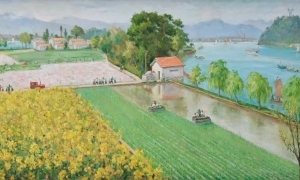吴笛笛的作品在挖掘传统绘画艺术方面有着自己独特的体悟和感受。对新疆克孜尔洞窟早期佛教壁画的深入与细腻的研究和考察,以及大量临摹,使她对艺术的理解和表达超越了时空限制与文化的隔阂,从而连接了远古的视觉文化与今天的造型世界。她曾经根据传统壁画的造型与图式语言完成了一批古意盎然的作品,例如《粉红》,《他在哪儿》,《订婚》等。这个展览上展出的是她的近作《十二生肖系列》。这套作品是她对包括剪纸,青花瓷绘,木刻,皮影等传统民间艺术与古代壁画艺术的系统整合,并在图式和语言上进行现代性的提炼。在作者看来,西方现代艺术史上的许多大师都从土著和乡土艺术中获取过营养,她因此试图运用现代艺术语言来表现属相动物所代表的人性。作品不仅表达了艺术家对农业时代的宁静田园世界的想象,而且体现了她传统视觉文化的深入研究和体悟,而轻松的风格,质朴的艺术语言,以及稚拙的造型也让观众暂时超越了世俗生活的烦恼,而进入一个个富有亲和力的动物“境界”。在可爱的动物身上寻找人性,也许是表达了艺术家对当今世俗间兽性泛滥的忧虑。
张朝晖
2005年2月
Wu Didi is unigue in her understanding of traditional art. Her indepth and detailed study and copying of the Kazakh Caves of the Thousand Buddhas in Xinjiang helps to formulate an artistic understanding that goes beyond spatial ,temporal and cultural boundaries. In her paintings,the visual cultures of the antiquity and the present are allowed to meet. She based a series of work ,including“Pink”,“He is there”and“Engagement”,on graphic forms of mural paintings. The exhibition includes her recent work. “12 Chinese Zodiac Signs”. By systematically combining ancient mural art with various types folk art, such as paper cutting ,blue-and-white porcelain painting, woodcut and shadow puppet,she also attempts to modernise their graphic forms. She believes that many masters in the West found their inspiration from folk arts. Therefore in her works ,modern artistic language is employed to show human nature in zodiac signs. Not only as the imagining of an idyllic world, these paintings also demonstrate her understanding of the traditional visual culture. The easygoing style, the rustic language,and the naïve graphic forms, all help to transport the viewer to a realm devoid of everyday troubles –yet rich in animal affinity. Perhaps to search for human nature in cute animals can be seen as a response to the degradation of modern human nature.
【编辑:贾娴静】





















